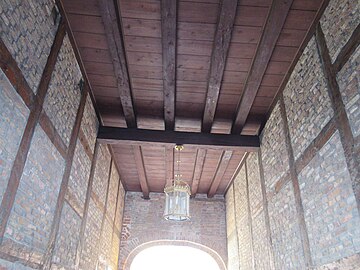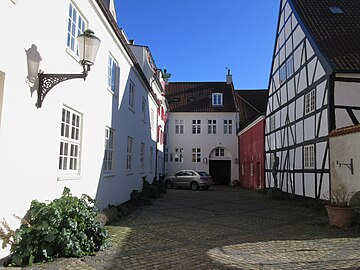
The Lehn House is a historic townhouse on Strandgade in the Christianshavn neighbourhood of central Copenhagen, Denmark. It is also known as the Tordenskjold House after Peter Jansen Wessel Tordenskiold commonly referred to as Tordenskjold, who for a while lived in the building. The Danish Authors' Society is now based in the property whose meeting facilities are also rented out for events. The rooms are notable for their lavish stucco ceilings and murals.

The Strandgade 24 is a listed Neoclassical townhouse located on Strandgade in Copenhagen, Denmark.

The Cort Adeler House is a historic property located at Strandgade 22 in the Christianshavn neighbourhood of Copenhagen, Denmark. It takes its name from Admiral Cort Adeler who lived there for the last seven years of his life in the 17th century.

The Niels Brock House is a historic property located at Strandgade 36 in the Christianshavn neighbourhood of Copenhagen, Denmark. The property comprises the former warehouse at Wildersgade 51 on the other side of the block as well as a number of side wings in the yard. The building takes its name after the businessman Niels Brock for whom it was adapted in the 1780s. Other notable former residents include the historian Peter Vilhelm Jacobsen (1799–1848) and the businessman Christian August Broberg. The entire complex was listed in the Danish registry of protected buildings and places in 1918.
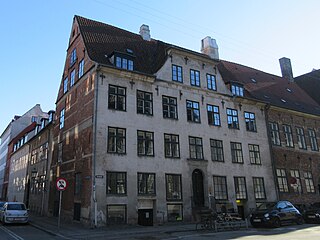
The Mikkel Vibe House is a historic property located at Strandgade 32 in the Christianshavn neighbourhood of Copenhagen, Denmark. It is believed to be the oldest building in Christianshavn and takes its name after Mikkel Vibe who was mayor of Copenhagen.

The Jennow House is a historic property located at Strandgade 12 in the Christianshavn neighbourhood of Copenhagen, Denmark. It takes its current name after Andreas Jennow, a businessman who owned it from 1949 to 1978. His company Andreas Jennow A/S was based in the building until 1988.

The Schottmann House Danish: is a historic property located at Strandgade 10 in the Christianshavn neighbourhood of Copenhagen, Denmark.

The Rhode House is a historic property located at the corner of Strandgade and Torvegade in the Christianshavn neighbourhood of central Copenhagen, Denmark.

The Jacob Holm House is a historic property located at Strandgade 4B in the Christianshavn neighbourhood of Copenhagen, Denmark. It was owned by the wealthy industrialist and shipowner Jacob Holm from 1819 to 1845. The building remained in the hands of the Holm family for more than 100 years. A plaque on the facade commemorates that N. F. S. Grundtvig was a tenant on the building.

Rosenborggade 7–9 is a complex of mid-19th-century buildings situated at the corner of Rosenborggade and Tornebuskegade, close to Nørreport station, in the Old Town of Copenhagen, Denmark. It consists of a large corner building, an adjacent building in Rosenborggade and a warehouse in the courtyard. The entire complex was listed in the Danish registry of protected buildings and places in 1975. A plaque on the facade of No. 7 commemorates that the philosopher Søren Kierkegaard resided in the building from 1848 to 1850 and that he wrote The Sickness unto Death and Practice in Christianity while he lived there. Other notable former residents include the actors Ludvig and Louise Phister who lived in the apartment on the second floor of No. 7 from 1859 until their deaths in 1896 and 1916.

Kompagnistræde 14 is a Neoclassical property situated on Strædet in the Old Town of Copenhagen, Denmark. Like most of the other buildings in the area, it was constructed as part of the rebuilding of the city following the Copenhagen Fire of 1795. A four-storey warehouse in the courtyard dates from 1855. The entire complex was listed in the Danish registry of protected buildings and places in 1939.

Brolæggerstræde 4 is a Neoclassical property situated in the Old Town of Copenhagen, Denmark. Like most of the other buildings in the area, it was constructed as part of the rebuilding of the city following the Copenhagen Fire of 1795. The three-winged complex was listed in the Danish registry of protected buildings and places in 1950.

Kringlegangen is a passageway linking the square Gråbrødretorv with the street Valkendorfsgade in the Old Town of Copenhagen, Denmark. A bakery was operated on the site from before 1787 until at least the 1910s. The present building complex was constructed in 1856-1857 for master joiner Carl Heinrich Winther. The passageway was not opened to the public until 1975. The name Kringlegangen was inspired by a gilded kringle above the entrance from Gråbrødretorv as well as to the twisting and turning course of the passageway. The entire building complex was listed in the Danish registry of protected buildings and places in 1945.

Torvegade 28/Wildersgade 26 is an 18th-century building complex situated on the corner of Torvegade and Wildersgade in the Christianshavn neighborhood of central Copenhagen, Denmark. It consists of a four-storey corner building and an adjacent three-storey former warehouse in Wildersgade. The two buildings were both heightened with one storey in 1852. The property was for almost two hundred years—from 1727 until 1917—owned by bakers. Their bakery was located in a side wing. A sandstone tablet with a relief of a crowned kringle and a cartouche with the initials of a former owner and the year ""Anno 1770" can still be seen above the shop entrance in Torvegade. The entire complex was listed in the Danish registry of protected buildings and places in 1982.

The Sigvert Grubbe House is a Renaissance style townhouse situated at Strandgade 28 in the Chrstianshavn neighborhood of central Copenhagen, Denmark. The property comprises the building at Wildersgade 41 on the other side of the block as well as a half-timbered building separating two central courtyards from each other. The apartment on the first floor features a number of murals attributed to Nicolai Abildgaard. The entire complex was listed in the Danish registry of protected buildings and places in 1918. It takes its name after its first owner, Sigbert Grubbe, a favourite of ChristianIV. It was later owned by Jacob Benjamin Italiaender, a Sphardi Jew, who established a tobacco manufactory as well as a private sunagogue in the yard. The painter Peder Severin Krøyer grew up in the building in the 1860s.

Wildersgade 15 is an 18th-century property situated on Wildersgade in the Christianshavn district of central Copenhagen, Denmark. It was listed in the Danish registry of protected buildings and places in 1964. It is now owned by Folketinget and contains eight apartments available to MPs from the provinces.
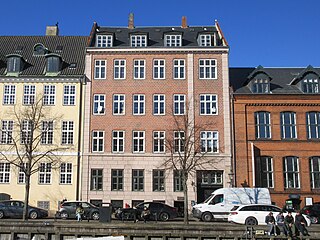
Overgaden Neden Vamdet 15 is a mid-19th-century property overlooking the Christianshavn Canal in the Christianshavn neighborhood of central Copenhagen, Denmark. It consists of an L-shaped building with high-end apartments from 1858 fronting the street and an older rear wing now used as office space, ateliers and storage space. The two buildings were both listed in the Danish registry of protected buildings and places in 1980. Notable former residents include the businessman Peter Heering and the author Henrik Pontopidan.

The Gerling House is a late 17th-century building complex situated at Strandgade 38 in the Christianshavn district of central Copenhagen, Denmark. It consists of a three-storey, four-bays-wide front wing towards the street and a 13-bays-long two-storey side wing on its rear. The master cooper Peter Richter established a cooper's workshop in the building in the 1830s and the property was after his death owned by his widow until 1880. The building was listed in the Danish registry of protected buildings and places in 1918. Notable former residents include the naval officer and painter Sophus Schack.

Naboløs 3 is a Neoclassical building situated around the corrner from Gammel Strand in the Old Town of Copenhagen, Denmark. It was listed on the Danish registry of protected buildings and places in 1945.
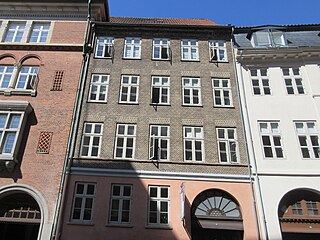
Nørregade 27 is a Neoclassical building situated on Nørregade in central Copenhagen, Denmark. It was constructed for a master tanner in the 1830s after the previous building on the site had been destroyed in the British bombardment of Copenhagen in 1807. In 1907, it was acquired by KTAS and merged with the adjacent Telephone House. In 1931, Nørregade 29 was also acquired by KTAS and merged with the complex. Nørregade 27 and Nørregade 29 were both listed in the Danish registry of protected buildings and places in 1939.












